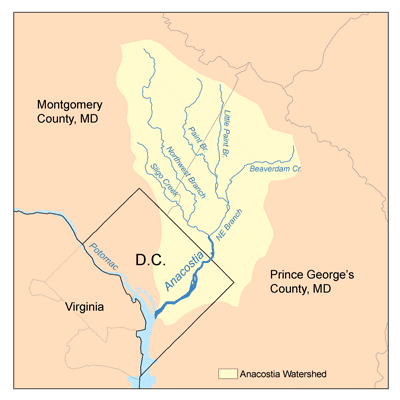
Polluted and neglected for decades, the Anacostia River is undergoing a renaissance thanks to years of community advocacy. Local governments have made strides fixing all the major pollution sources: bacteria, polluted stormwater runoff, trash, and toxics. But the hardest work is still ahead of us.
Bacteria
Combined sewers in much of DC discharge a mix of stormwater runoff and untreated sewage, while upstream in Maryland wastewater pipes are aging out and breaking. Soon DC Water will complete a multibillion dollar storage tunnel to capture 98% of discharges and in Maryland WSSC has ramped up efforts to repair their pipes but needs to do more.
Polluted Runoff
When it rains, hard surfaces like roofs, roads, and parking lots prevent water from soaking into the ground and instead send it rushing into streams, carrying dirt, chemicals, and trash along with it. DC, Montgomery, and Prince George’s have strong requirements for new construction that will keep this problem from getting worse, but all three are facing years of expensive retrofits to fix existing pollution.
Trash
The Anacostia River is only the second river in the entire US to be declared “impaired by trash.” Local governments are off to a good start reducing trash before it starts, banning foam food containers and placing a fee on disposable plastic bags, but must tackle other sources.
Toxics
There are six known “legacy toxic sites” along the Anacostia, and DC has recently studied toxics in the river bottom sediment. While some of the legacy sites are being cleaned up, there is no comprehensive plan underway.
What’s next?
Residents need to speak up and let public officials know that it’s time to finish the job and restore the Anacostia! We need to:
- Speed up infrastructure investments that fix pipes and reduce pollution laden runoff
- Pass bottle bills and other source reduction measures that stop litter before it starts
- Fund the clean up of toxics in and around the river and go after polluters
- Improve river parklands, and increase community access, for the benefit of long-term & current residents
Learn more: http://www.cleanwater.org/campaign/toxic-free-anacostia
